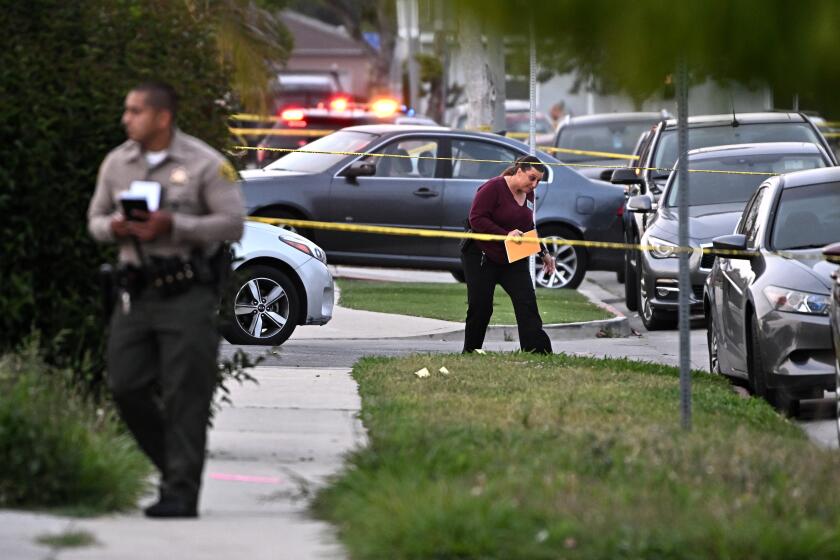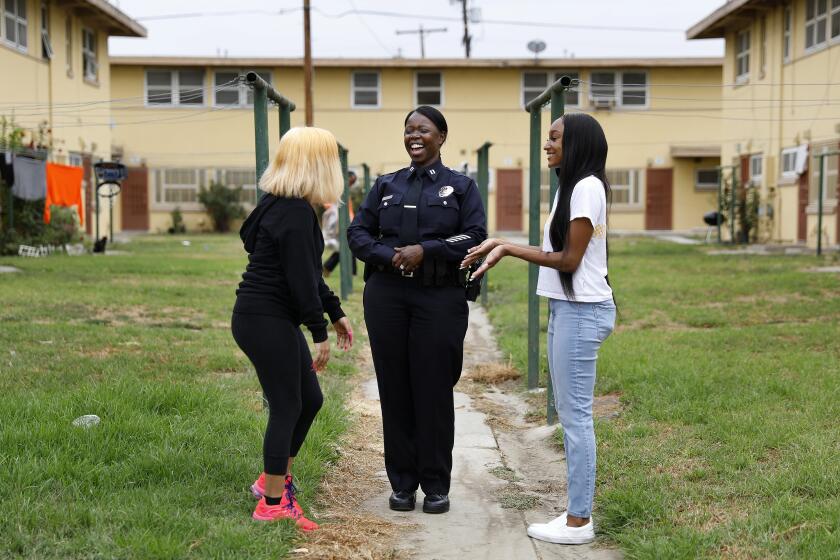Hope emerges in 2022 as homicides dip in Los Angeles

- Share via
After one of its deadliest stretches in recent memory, Los Angeles will end 2022 with fewer homicides and shootings than in 2021, sparking hope that the surge in violent crime over the previous two years is flattening.
The number of killings stood at 373 citywide through Christmas Eve — still well above pre-pandemic levels but a 6% decrease from the same time last year, according to preliminary statistics compiled by the Los Angeles Police Department. The city logged 397 homicides last year — its largest total since 2006.
The number of people struck by gunfire also fell 8% compared with the same period last year.
Police officials have attributed the turnaround in part to improved community involvement and closer cooperation with other law enforcement agencies.
The year began on an ominous note, with the pace of killings through the first few months threatening to eclipse the 15-year high set in 2021. Through April 30, there were 122 homicides in L.A., including the orchestrated shooting of a man by a suspect who police say flew in from Texas and the death of a man gunned down at a cemetery.
People are being killed in Los Angeles in 2022 at near the same elevated rate as last year, when homicides hit a 15-year high, according to LAPD data.
Several high-profile homicides, like the daytime slaying of rapper PnB Rock, who was fatally shot at Roscoe’s House of Chicken & Waffles in South L.A., fueled reports in the news and on social media about the city’s growing lawlessness. But the bloodshed abated somewhat in the ensuing months.
After steadily dropping from the highs of the early 1990s, when bloody gang wars drove homicides to more than 1,000 a year, violent crime spiked in L.A. in the first two years of the pandemic. Other cities saw similar increases as COVID shutdowns increased unemployment and exacerbated the affordable housing crisis.
Anastasiia Timmer, a criminology professor at Cal State Northridge, said that even as the hardships brought on by the pandemic are still being felt, the effects on crime may recede over time as people adapt to “cumulative stresses.”
“Maybe now we see less violent behavior, because stress also reaches its ‘ceiling effect,’” said Timmer, who with a group of colleagues has embarked on a study of how global events such as war or pandemic affect crime rates in six countries, including the U.S. “People adjust to living with COVID, even though it’s still there.”
She questioned whether the crime data released by the LAPD accurately reflect reality or is being underreported, at a time when trust in law enforcement hit new lows after the murder of George Floyd in 2020.
The horror of watching Floyd gasping for air under the knee of a Minneapolis police officer led to a mass protest movement across the country. Such abuses, experts say, can encourage people to take the law into their own hands, rather than turn to a criminal justice system that they view as not legitimate.
Some experts argue that with the U.S. opening back up, the likely causes of the spikes in violence nationwide are easing as the pandemic abates. For example, many social services that kept people safe are back up and running, and most schools are back to in-person learning, leaving fewer adolescents unsupervised with idle time on their hands.
But criminologists, police officials and other experts also caution that any single year can be an aberration, and the causes of the 2020 and 2021 spikes may never be fully understood.
LAPD officials have been measured in their reaction to the drop in homicides and shootings. In public appearances, Police Chief Michel Moore has repeatedly praised the Community Safety Partnership, a program started in 2011 that dedicates officers to working with community members in high-crime neighborhoods.
Amid a national movement to defund the police and reinvest the money to help Black and Latino residents, the LAPD will expand its signature community policing program.
Recent months have also seen a decline in so-called follow-home robberies, in which armed crews target and rob wealthy Angelenos after spotting them at high-end hotels, restaurants and clubs. Authorities say they believe that multiagency task forces aimed at cracking down on these robberies and on ghost guns are also working.
Crime emerged as a key issue in local elections, as political ads often painted Los Angeles as a failed state where violent criminals have free rein.
Mayor Karen Bass, who defeated a tough-on-crime candidate to become the city’s first female chief executive, ran on pushing a public health response to violence. Earlier this year, she released a plan that calls for hiring hundreds of new police officers, while also emphasizing structural issues and enhancing the economic and social vitality of communities.
In Los Angeles, violent crime was up less than 1% compared with Dec. 24 of last year. While most other categories showed declines, robberies were up 7% citywide. The police bureaus that cover South L.A., the San Fernando Valley and downtown and the city’s East Side all saw double digit increases in robberies, LAPD statistics show.
Property crimes through Dec. 24 were up about 10% from 2021, with the downtown and Rampart areas seeing the biggest jumps. Meanwhile, burglaries went up 12.5%. Motor vehicle thefts rose more than 5% over last year and more than 20% over 2020.
South L.A., home to neighborhoods fractured by decades of governmental neglect that were hardest hit by the gang wars of the 1990s, is again bearing the brunt of the city’s bloodshed. But fewer lives were lost there than last year, with homicides down 15% in South Bureau, which also includes San Pedro. The number of people struck by gunfire was down 22%, department data show.
A department spokeswoman wrote in an email that the crime statistics available on the LAPD’s website are preliminary, with the final numbers publicly announced early next year.
Some major U.S. cities have seen similar declines. In Houston, the police chief announced in a news conference in November that violent crime had fallen 8.5% compared with the same time in 2021. On the other hand, Philadelphia is on pace to eclipse last year’s homicides, and the number of robberies have more than doubled over since last year.
In areas patrolled by the Los Angeles County Sheriff’s Department, homicides declined from 263 to 178 through November, the most recent month for which data were available. In the same period, however, robberies and aggravated assaults rose 26% and 13%, respectively. Burglaries were up 36%.
The city of Compton saw a 54% drop in homicides this year through November, from 35 to 16, but robberies were up 25% and burglaries increased by 43%, according to sheriff’s statistics.
In West Hollywood, which passed a controversial plan to decrease the number of sheriff’s deputies in favor of unarmed security guards, robberies increased by 15%, aggravated assault by 25% and larceny theft by 90%.
While deadly violence remains a problem in some neighborhoods, LAPD Capt. Adrian Gonzalez of South Bureau Homicide said his detectives are solving more cases, a possible sign that residents in areas plagued by crime may be starting to trust police more after the tumult of the past few years. A reduction in gang violence has resulted in fewer homicides and shootings, he said.
The pandemic is almost certainly to blame for the earlier increases, but easy answers for why crime falls or rises are hard to come by, he said.
“A lot of tension, people being inside [because of] COVID, people just experiencing a lot of loss, and not just through death, but jobs and schools and connections with family and all those different things,” he said.
Fernando Rejón, executive director of L.A.’s Urban Peace Institute, said the drop in homicides is encouraging. But considering the recent decadelong stretch with less than 300 homicides a year, there is much more work to do, he said.
Urban Peace is part of a coalition that unveiled a crime-fighting blueprint earlier this year, calling for the restoration of funding for gang outreach cut during the pandemic.
“Any life saved, you can’t even put a measurement on that,” he said.
More to Read
Sign up for Essential California
The most important California stories and recommendations in your inbox every morning.
You may occasionally receive promotional content from the Los Angeles Times.













